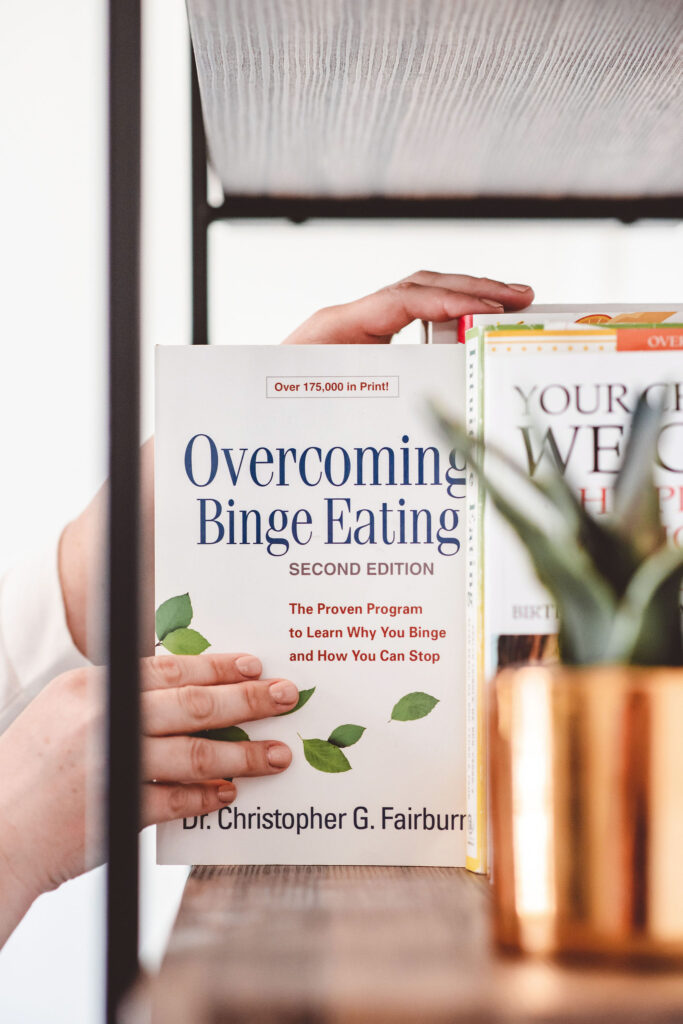If you’ve been dieting or following food rules for years, hunger and fullness cues can feel unreliable. Maybe you eat because the clock says it’s time, not because you’re truly hungry. Or you stop eating when the calories run out instead of when your body feels satisfied. Reconnecting to hunger and fullness cues is possible, but it takes patience, practice, and self-compassion.
This process is not about perfection. It’s about slowly building trust with your body again.
Before we dive in….Hi, I’m Meredith MacKenzie, a binge eating therapist and intuitive eating coach. If you’ve been ignoring your hunger and fullness cues for years, you’re not alone, and there’s nothing wrong with you. Your body’s signals can be rebuilt with patience and compassion. Through my One Body To Love program, I help women reconnect with these cues, heal their relationship with food, and trust their bodies again. For more daily tips and encouragement, join me on Instagram.

Why Hunger and Fullness Feel Confusing
Many people think hunger and fullness cues are simple, you just eat when you’re hungry and stop when you’re full. But if you’ve been disconnected from these signals for a long time, they can feel faint, inconsistent, or even absent.
Diet culture is a big reason for this. Years of following “rules” about when and how much to eat teaches you to override your body’s messages. Skipping meals to “save calories” or forcing yourself to stop eating before you’re satisfied sends your body the signal that its natural cues can’t be trusted.
Chronic stress, emotional eating, busy schedules, certain medications, and even childhood food experiences can also dull these signals. Over time, you might not recognize them at all.
The good news is that your body hasn’t forgotten how to communicate. The signals are still there, they just need some space and attention to come through again.
Clear out the diet culture messages that make you doubt your hunger and fullness cues. Read how to spot them here.
Understanding Hunger: The Different Types
When people hear “hunger,” they usually think of an empty stomach. But hunger shows up in more than one way. Learning the different types can help you notice them earlier and respond in ways that feel good.
- Physical hunger: Your body’s actual need for food. Signs may include stomach growling, low energy, lightheadedness, trouble concentrating, or irritability.
- Taste hunger: A craving for a specific flavor or texture, even if you’re not physically hungry. Often sparked by seeing, smelling, or thinking about certain foods, or during celebrations.
- Practical hunger: Eating because you know you won’t have a chance later. For example, having lunch before a long meeting even if you’re not very hungry yet.
- Emotional hunger: The urge to eat for comfort, distraction, or reward. It’s natural to have emotional connections to food, but noticing them can help you choose how to respond.
When you can tell which type of hunger you’re experiencing, it becomes easier to decide what will meet your needs in the moment.
Start tuning into your hunger and fullness cues with my free Mindful Eating Log. Download it here.

Understanding Hunger and Fullness Cues: Moving Beyond the “Clean Plate Club” Mentality
Many of us grew up with the “finish your plate” rule, no matter how full we felt. Over time, that can lead to tuning out your hunger and fullness cues and missing the moment when your body has had enough.
Fullness is more than just feeling stuffed. It’s also about satisfaction. You might be physically full but not satisfied if the food didn’t match what you were craving or if you were distracted while eating.
Fullness often feels like a gentle sense of comfort, your energy returning, or your hunger signals fading. It’s rarely an instant shift, it tends to build slowly. Noticing that middle ground, when you feel satisfied but not overly full, can help you stop eating in a way that feels comfortable and natural.
Learn how people-pleasing can keep you stuck in emotional eating patterns and what to do instead. Read the blog here.
Rebuilding Trust with Gentle Curiosity
If you’ve been ignoring hunger and fullness cues, it’s tempting to jump in and try to “do it right” immediately. But trust takes time. Your body needs to learn that you’ll respond consistently to its needs before the cues get louder.
Approach this with gentle curiosity instead of judgment. Notice what you feel before, during, and after eating. Instead of thinking “I shouldn’t be hungry” or “I’m eating too much,” ask, “What might my body be telling me?”
You may find that at first, hunger and fullness signals are unpredictable. Some days you might not feel them at all. Other days they might be very strong. This is part of the process.
Want to see what trusting your hunger and fullness cues can look like in everyday life? Watch this video.
Practical Exercises to Reconnect to Hunger and Fullness Cues
Rebuilding trust with your hunger and fullness cues takes consistent, gentle practice. These simple exercises can help you start noticing and responding to your body’s signals again:
- Check in before eating: Pause for a few seconds before your first bite. Ask yourself if you feel physically hungry and notice any sensations in your body. No need to change what you eat, just observe.
- Try a hunger/fullness scale: Rate your hunger from 0 (empty, dizzy) to 10 (uncomfortably full). Aim to begin eating around 3–4 and stop around 6–7. This is a guide, not a rule.
- Limit distractions when possible: Put away screens or other multitasking during meals. Even a few distraction-free bites can help you notice your body’s signals more clearly.
- Pause mid-meal: About halfway through eating, set your utensil down and take a breath. Check if your hunger has changed and if the food is still as appealing.
- Track your patterns: Keep a short, simple journal of when and why you eat. Over time, notice what affects your cues; such as stress, meal timing, certain foods, or social settings.
You don’t need to master all of these at once. Even choosing one or two to try regularly can make your hunger and fullness cues feel easier to notice and trust.
Find out what might really be behind feeling out of control with food. Read the blog here.
Progress Over Perfection
Reconnecting with hunger and fullness cues is not about perfect eating. Some days you’ll eat past fullness. Some days you won’t notice hunger until you’re starving. That doesn’t mean you’ve failed, it means you’re learning.
Celebrate small wins, like noticing hunger a little earlier or stopping before you feel uncomfortable. These are signs your body is starting to trust you again.
If you’ve spent years ignoring or overriding your cues, it makes sense that they’ll take time to come back. Each time you respond to them with kindness, you’re building a stronger connection.
Remember: your hunger and fullness cues are not rules to follow. They’re information. You get to decide how to use that information in a way that works for you.
If you’re unsure whether your eating patterns are helping or hurting your well-being, watch this.
The Bottom Line on Reconnecting with Your Hunger and Fullness Cues
Hunger and fullness cues are your body’s built-in guidance system for eating. If they feel faint or unreliable right now, you’re not broken, you’ve simply been taught to ignore them. By approaching them with curiosity, practicing simple awareness tools, and letting go of the idea of perfection, you can rebuild trust in your body.
When you do, food becomes less about control and more about connection. And that’s where true food freedom starts.
If tuning into your hunger and fullness cues feels confusing after years of dieting, food rules, or ignoring your body’s needs, you are not alone. These patterns make sense, and they can be rebuilt with care, not control.
In my group program, One Body To Love, and in 1:1 coaching, I help women reconnect with these cues, step out of the binge-restrict cycle, and trust their bodies again.
Not sure where to begin? Book a free discovery call. Or explore the One Body To Love podcast and my YouTube channel for honest, supportive conversations about food and body trust.
